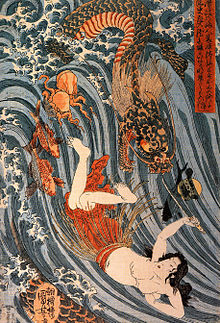
Back تنين ياباني Arabic জাপানী ড্ৰেগন Assamese Drac japonès Catalan Dragón japonés Spanish اژدهای ژاپنی Persian Dragon japonais French Dragón xaponés Galician Japán sárkány Hungarian Dracon japonese Interlingua Drago giapponese Italian





Japanese dragons (日本の竜/龍, Nihon no ryū)[a] are diverse legendary creatures in Japanese mythology and folklore. Japanese dragon myths amalgamate native legends with imported stories about dragons from China, Korea and the Indian subcontinent. The style and appearance of the dragon was heavily influenced by the Chinese dragon, especially the three-clawed long (龍) dragons which were introduced in Japan from China in ancient times.[1]: 94 Like these other East Asian dragons, most Japanese ones are water deities or kami[2] associated with rainfall and bodies of water, and are typically depicted as large, wingless, serpentine creatures with clawed feet.
Cite error: There are <ref group=lower-alpha> tags or {{efn}} templates on this page, but the references will not show without a {{reflist|group=lower-alpha}} template or {{notelist}} template (see the help page).
- ^ Bates, Roy (2007). All about Chinese dragons. Beijing: China History Press. ISBN 978-1-4357-0322-3. OCLC 680519778.
- ^ Carlson, Kathie; Flanagin, Michael N.; Martin, Kathleen; Martin, Mary E.; Mendelsohn, John; Rodgers, Priscilla Young; Ronnberg, Ami; Salman, Sherry; Wesley, Deborah A. (2010). Arm, Karen; Ueda, Kako; Thulin, Anne; Langerak, Allison; Kiley, Timothy Gus; Wolff, Mary (eds.). The Book of Symbols: Reflections on Archetypal Images. Köln: Taschen. p. 280. ISBN 978-3-8365-1448-4.